
This article is part of a two-part series. See the second article here.
COVID-19 has spawned a flood of potentially deadly mis- and disinformation that directly impacts lives and livelihoods around the world. UN Secretary General António Guterres has described this as a “poison,” and humanity’s other new “enemy.”
As part of the UN’s response to the crisis, we were commissioned to produce two new policy briefs published today by the United Nations Educational Scientific and Cultural Organization (UNESCO), with the support of ICFJ. The goal is to help the UN, governments, journalists, civil society and internet communications companies respond to the crisis — and to ensure that freedom of expression rights are not undercut in the process. This research highlights journalism’s critical role in fighting back.

What is the disinfodemic?
The term we have adopted to describe the falsehoods fuelling the pandemic is disinfodemic because of the huge viral load of potentially deadly disinformation. The disinfodemic often hides falsehoods amidst true information, and conceals itself in the clothes of familiar formats. It resorts to well-known distribution methods ranging from false or misleading memes and fake sources, through to trapping people into clicking on links connected to criminal phishing expeditions. It can be shared by individuals, organized groups, news media and official channels — either wittingly or unwittingly.
To help navigate this crisis, we have identified and critically analyzed 10 different categories of responses to the disinfodemic, and made a range of recommendations for action (see part two of this ICFJ series). But to start, we mapped nine key themes and four main format types associated with the disinfodemic.
Key themes of the disinfodemic
(1) Origins and spread of the coronavirus/COVID-19
While scientists first identified cases of the novel coronavirus connected to an animal market in the Chinese city of Wuhan, there are many conspiracy theories that accuse other actors and causes. These extend from blaming 5G networks to chemical weapons manufacturers. A label like “Chinese virus” instead of neutral terminology inflates location into an adjective, in an historical echo of early pandemics that gave a biased meaning to a noun.
(2) Medical science: symptoms, diagnosis and treatment
This theme includes dangerous disinformation about immunity, prevention, treatments and cures. For example, a myriad of memes claim that drinking or gargling cow urine, hot water or salt water could prevent the infection reaching lungs. They cannot.
(3) False and misleading statistics
In our research, we saw misrepresented and distorted data connected to the reported incidence of the disease and mortality rates.
(4) Impacts on society and the environment
This theme in the disinfodemic ranges from panic-buying triggers and false information about lockdowns, to the supposed re-emergence of dolphins in Venetian canals.
(5) Economic impacts
This theme includes spreading false information about the economic and health impacts of the pandemic, suggestions that social isolation is not economically justified and even claims that COVID-19 is overall creating jobs.
(6) Politicization
One-sided and positively framed information is presented in an effort to negate the significance of facts that are inconvenient for certain actors in power. Other disinformation designed to mislead for political advantage includes equating COVID-19 with flu, making baseless claims about the likely length of the pandemic and assertions about the lack of availability of medical testing and equipment.
(7) Discrediting journalists and credible news outlets
This is a theme often associated with political disinformation, with unsupported accusations that certain news outlets are themselves peddling in disinformation. This behavior includes abuse levelled at journalists publicly, but it is also used by less visible disinformation campaigns to undermine trust in verified news produced in the public interest. Attacks on journalists in the time of COVID-19 have been associated with crackdowns on critical coverage of political actors and states.
(8) Content driven by fraudulent financial gain
This includes scams designed to steal people’s private data.
(9) Celebrity-focused disinformation
This includes false stories about actors being diagnosed with COVID-19.
The four main formats of COVID-19 disinformation
COVID-19 disinformation has harnessed a wide range of formats. Many have been honed in the context of anti-vaccination campaigns and political disinformation. These formats frequently smuggle falsehoods into people’s consciousness by focusing on beliefs rather than reason, and feelings instead of deduction. They rely on prejudices, polarization and identity politics, as well as credulity, cynicism and individuals’ search to make sense of great complexity and change.
The contamination typically spreads in text, images, video, memes and sound.
(1) Emotive narrative constructs and memes
While these formats often include elements of truth, it is mixed with strong emotional language, lies and/or incomplete information, and personal opinions. These formats are particularly hard to uncover on closed messaging apps.
(2) Fraudulently altered, fabricated or decontextualized images and videos
These are used to create confusion and generalized distrust and/or to evoke strong emotions through viral memes or false stories.
(3) Disinformation infiltrators and orchestrated campaigns
These are aimed at sowing discord in online communities, advancing nationalism and geopolitical agendas, collecting personal health data and phishing, or gaining money from spam and advertisements for false cures. These formats may also include artificial amplification and antagonism by bots and trolls as part of organized disinformation campaigns.
(4) Fabricated websites and authoritative identities
These include false sources, polluted datasets and fake government or company websites, as well as other websites publishing seemingly plausible information in the genre of news stories (i.e. reporting bogus cases of COVID-19).
These are the main themes and format types of COVID-19 disinformation that our research identified. In part two of this series, we will identify ten types of responses to the disinfodemic emerging internationally, and we will analyze these with reference to significant freedom of expression challenges. We will also make a range of recommendations highlighting journalism’s critical role in the fight to defend truth.
by Julie Posetti and Kalina Bontcheva, International Journalists’ Network
Related posts
Magazine Training International’s mission is to encourage, strengthen, and provide training and resources to Christian magazine publishers as they seek to build the church and reach their societies for Christ.

